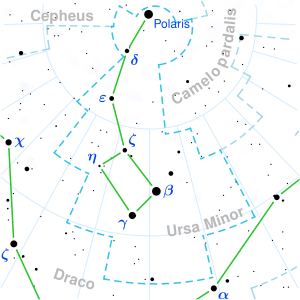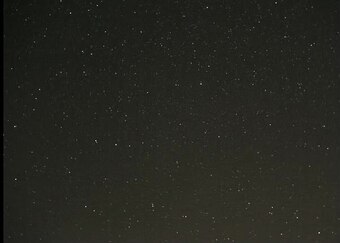Celestial pole
The points of intersection of the earth's axis with the celestial sphere are called celestial poles . The celestial north pole is the point near the pole star (α Ursae minoris) in the constellation Little Bear (or Little Dipper ) around which the celestial vault apparently rotates in its daily movement ; the south celestial pole is opposite it, but only a faint star, σ Octantis, lies near it .
The celestial pole is not completely stable relative to an observer on the earth's surface. Due to the pole movement , it easily wanders in a complex movement, which can be represented in simplified form as a superposition of circular movements and a drift.
Equatorial coordinate system
On the celestial sphere , on which astronomy defines the equatorial celestial coordinates right ascension and declination , the celestial poles lie exactly above the geographic north pole (or south pole ).
The hour circles converge in the celestial poles , and the meridian of an observation point also runs through the celestial poles. The north celestial pole corresponds to a declination of exactly 90 °, the south pole of −90 °.
Movement of the celestial pole
As a result of the precession effect , the celestial pole moves around the ecliptic pole (in the center of the images) over the course of 25,800 years (the cycle of precession ). This movement takes place on a circle with a pole distance of about 23 ° , which corresponds to the current " obliqueness of the ecliptic ". Around 5000 years ago, Thuban (the main star α Draconis in the dragon ) was the pole star , then the faint Kappa Draconis and around 3000 years ago Kochab in the Little Bear . Today it is the star Alpha Ursae Minoris or Polaris (Pole Star). From the year 3000 the celestial north pole will be in the constellation Cepheus . In about 12,000 years the bright Vega will be the new Pole Star (however approx. 6 degrees from the true north celestial pole).

The path of the south celestial pole around the ecliptic pole.
The bright star near the center of the image is Canopus |
Miscellaneous
All stars move on their apparent daily orbits ( Earth's rotation in 23:56:04 hours) on a circular orbit exactly in the direction of a position angle of 90 °.
For the calibration of photometers , a group of fixed stars has been defined around the northern celestial pole , the pole sequence or north polar sequence . Their apparent brightness was measured precisely and covers a range from the 4th to the 10th magnitude.
The position angle for specifying directions between double stars or directions of movement relates to the respective direction from the star to the north celestial pole.
See also
Web links
- Walter Fendt: The celestial poles - connection between the observation point, zenith, celestial pole




